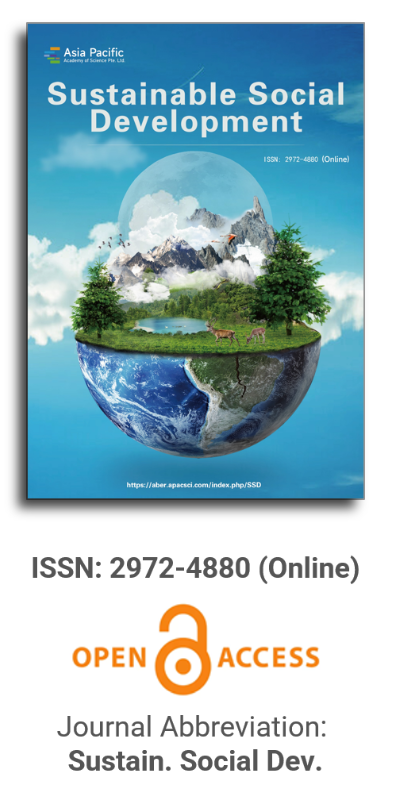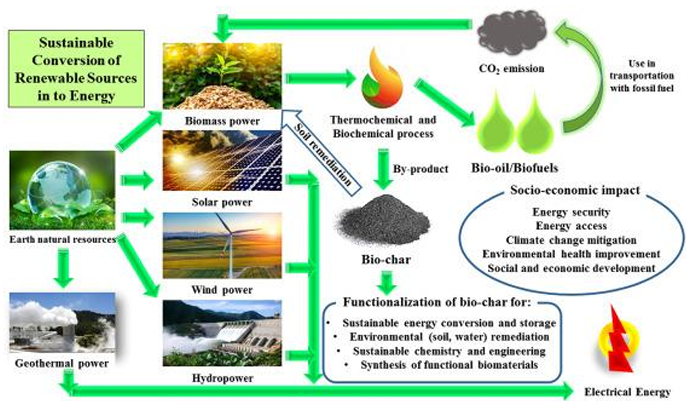
Asia Pacific Academy of Science Pte. Ltd. (APACSCI) specializes in international journal publishing. APACSCI adopts the open access publishing model and provides an important communication bridge for academic groups whose interest fields include engineering, technology, medicine, computer, mathematics, agriculture and forestry, and environment.

The characteristics of bio-digester owners and effects of biogas utilization on woodfuel and emission reduction in Gambella, Oromia, southern nations and Somalia regions of Ethiopia
Vol 1, Issue 3, 2023
Download PDF
Abstract
Biogas is an environmentally friendly energy source produced from the anaerobic digestion of biodegradable biomass. In response to Sustainable Development Goal 7 (SDG7), a biogas programme and a biogas scale-up project were implemented in Ethiopia. In this study, a multi-stage sampling procedure was employed to select well-functioning bio-digesters that supply cooking energy and bio-slurry from bio-digesters constructed in April 2017 to April 2020 in the National Biogas Scale-Up Project (NBPE+) of Ethiopia. Then qualitative and quantitative data were collected through interviews with 59 households, 10 focus groups, and 20 key informants in 22 woredas in the Gambella, Oromia, SNNP, and Somalia regions. The type of digester was a dome-type one constructed underground. Qualitative data were narrated and summarized, and quantitative data were analysed for means of variance. Utilization of biogas energy reduced the wood fuel collection and consumption time by 38% in Gambella, by 50% in Oromia, SNNP, and by 55% in the Somalia region. The use of biogas reduced the amount of carbon emissions from woodfuel combustion by 7.28 tCO2e in Oromia to 2.78 tCO2e in Gambella. Although the households were highly interested in biogas technology, the cost of biodigester construction became unaffordable, and only 15% of the households requested credit. About 69.49% of the households constructed a 6-m3 biodigester. Overall, 16.95% of the households had four cattle, and 10.17% of them had nine cattle. In Gambella, the available feedstock was sufficient to feed only a 3.7 m3 bio-digester, while the mean size of the installed bio-digester was 6 m3 and as a result, only 61.7% of the size of the bio-digesters was filled by the available feedstock. The dung’s total solids and volatile solids were different among the regions that affected the amount of biogas production. The biogas production ranged from 0.01 to 1.75 m3, which was sufficient for cooking for 0.03 to 4.38 h. The highest mean amount of biogas and corresponding cooking hours were obtained in Somalia, about 0.51 ± 0.11 m3 and 1.27 ± 0.27 h based on the number of available cattle; however, there was a lack of water. Therefore, zero grazing, home feeding, and watering of cattle should be practiced for the sustainability of biogas production.
Keywords
References
- Shin HC, Park JW, Kim HS, Shin ES. Environmental and economic assessment of landfill gas electricity generation in Korea using LEAP model. Energy Policy 2005; 33(10): 1261–1270. doi: 10.1016/j.enpol.2003.12.002
- Erdogdu E. An expose of bioenergy and its potential and utilization in Turkey. Energy Policy 2008; 36(6): 2182–2190. doi: 10.1016/j.enpol.2008.02.041
- Amigun B, Sigamoney R, von Blottnitz H. Commercialisation of biofuel industry in Africa: A review. Renewable and Sustainable Energy Reviews 2008; 12(3): 690–711. doi: 10.1016/j.rser.2006.10.019
- Bi S, Hong X, Wang G, et al. Effect of domestication on microorganism diversity and anaerobic digestion of food waste. Genetics and Molecular Research 2016; 15(3): 1–4. doi: 10.4238/gmr.15038417
- Nigel K, Sneeringer S. Carbon prices and the adoption of methane digesters on dairy and hog farms. Available online: https://www.ers.usda.gov/webdocs/publications/42846/7864_eb16.pdf?v=0 (accessed on 24 November 2023).
- Wolde-Ghiorgis W. Renewable energy for rural development in Ethiopia: The case for new energy policies and institutional reform. Energy Policy 2002; 30(11–12): 1095–1105. doi: 10.1016/S0301-4215(02)00061-7
- Directorate of Global Energy Economics of the International Energy Agency. World Energy Outlook 2014. International Energy Agency; 2014. 726p.
- Food and Agriculture Organization of the United Nations. Global forest products: Facts and figures 2018. Available online: https://www.fao.org/3/ca7415en/CA7415EN.pdf (accessed on 24 November 2023).
- Federal Democratic Republic of Ethiopia. The path to sustainable development: Ethiopia’s climate-resilient green economy strategy. Available online: https://www.adaptation-undp.org/sites/default/files/downloads/ethiopia_climate_resilient_green_economy_strategy.pdf (accessed on 24 November 2023).
- Boers W, Workneh K, Esthete G. National Biogas Programme Ethiopia: Programme Implementation Document. Ethiopia Rural Energy Development and Promotion Centre; 2008. 105p.
- Guta DD. Assessment of biomass fuel resource potential and utilization in Ethiopia: Sourcing strategies for renewable energies. International Journal of Renewable Energy Research 2012; 2(1): 131–139.
- World Health Organization. Fuel for life: Household energy and health. Available online: https://iris.who.int/bitstream/handle/10665/43421/9241563168_eng.pdf?sequence=1 (accessed on 24 November 2023).
- Martínez CIP, Alfonso Piña WH. Energy efficiency in Colombia: Trends and challenges. International Journal of Energy Science 2014: 4(1): 31–34. doi: 10.14355/ijes.2014.0401.08
- Food and Agriculture Organization of the United Nations. The state of food and agriculture. Available online: https://www.fao.org/3/i0680e/i0680e00.pdf (accessed on 24 November 2023).
- International Energy Agency. World energy outlook 2022. Available online: https://iea.blob.core.windows.net/assets/830fe099-5530-48f2-a7c1-11f35d510983/WorldEnergyOutlook2022.pdf (accessed on 12 January 2023).
- Castro J, Kedir MF, Tesfay MK. Technical Evaluation of the Financing Agreement―Biogas Dissemination Scale-Up Project—National Biogas Programme of Ethiopia (NBPE+) ‖: Contract N° 300014017—SIEA-2018-2391. Proposal for Evaluation of European Development Fund for Ethiopia; 2021. pp. 1–79.
- Guardado Chacón JA. Design and Construction of Simple Biogas Plants (Spanish). Editorial Cubasolar; 2007.
- Kenpro. The blue flame: Biogas training blueprint. Available online: https://www.kenpro.org/tag/the-blue-flame-biogas-training-blueprint/ (accessed on 12 March 2023).
- Menya E, Alokore Y, Ebangu BO. Biogas as an alternative to fuelwood for a household in Uleppi sub-county in Uganda. Agricultural Engineering International: CIGR Journal 2013; 15(1): 50–58.
- Kefalew T, Tilinti B, Betemariyam M. The potential of biogas technology in fuelwood saving and carbon emission reduction in Central Rift Valley, Ethiopia. Heliyon 2021; 7: e07971. doi: 10.1016/j.heliyon.2021.e07971
- Kurchania AK. Biomass energy. In: Baskar C, Baskar S, Dhillon RS (editors). Biomass Conversion: The Interface of Biotechnology, Chemistry and Materials Science. Springer; 2012; pp. 91–122. doi: 10.1007/978-3-642-28418-2_2
- Arthur R, Baidoo MF, Antwi E. Biogas as a potential renewable energy source: A Ghanaian case study. Renewable Energy 2011; 36(5): 1510–1516. doi: 10.1016/j.renene.2010.11.012
- Kamp LM, Forn EB. Ethiopia’s emerging domestic biogas sector: Current status, bottlenecks and drivers. Renewable and Sustainable Energy Reviews 2016; 60: 475–488. doi: 10.1016/j.rser.2016.01.068
- Miklol Consulting and Research PlC. Biogas Dissemination Scale-Up Programme(NBPE+): Report of Bio-digester Users’ Survey (BUS). Miklol Consulting and Research PlC; 2019.
- Ghafoori E, Flynn PC, Checkel MD. Carbon credits required to make manure biogas plants economic. International Journal of Green Energy 2007; 4(3): 339–349. doi: 10.1080/15435070701332187
- U.S. Environmental Protection Agency. U.S. Anaerobic Digester Status Report. U.S. Environmental Protection Agency; 2010.
- Rajendran K, Aslanzadeh S, Taherzadeh MJ. Household biogas digesters—A review. Energies 2012; 5(8): 2911–2942. doi: 10.3390/en5082911
- ter Heegde F. Technical potential for household biodigesters in Africa. Available online: https://a.storyblok.com/f/191310/61a849e3e2/technical_brief_-_technical_potential_for_household_biodigesters_in_africa.pdf (accessed on 27 November 2023).
- Marie MF, Yirga GA, Azadi H. Status of energy utilization and factors affecting rural households’ adoption of biogas technology in north-western Ethiopia. Heliyon 2021; 7(3): e06487. doi: 10.1016/j.heliyon.2021.e06487
- Kasap A, Aktas R, Dugler E. Economic and environmental impacts of biogas. Journal of Agricultural Machinery Science 2012; 8(3): 271–277.
- Saroj R. Dissemination Scale-Up Programme Presentation. SNV Netherlands Development Organisation; 2021. p. 60.
Supporting Agencies
Copyright (c) 2023 Miftah Fekadu
License URL: https://creativecommons.org/licenses/by/4.0/

This site is licensed under a Creative Commons Attribution 4.0 International License (CC BY 4.0).

Prof. Kittisak Jermsittiparsert
University of City Island, Cyprus






It is with deep regret that we announce the cancellation of the Forum on Sustainable Social Development & Computing and Artificial Intelligence, originally scheduled for June 15, 2025.

